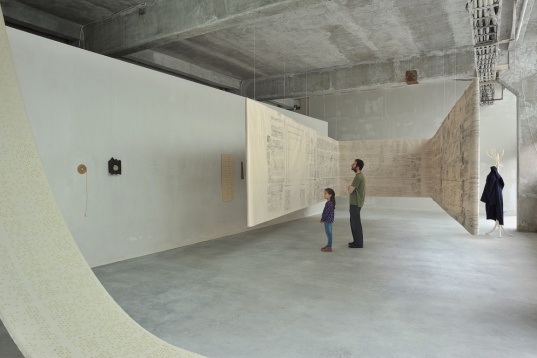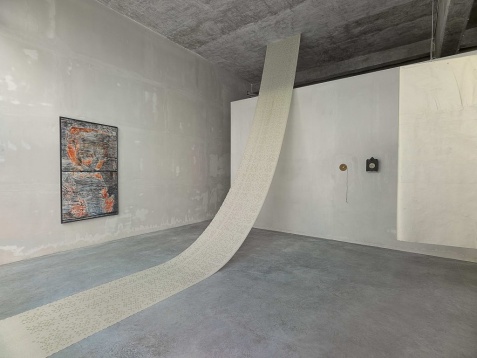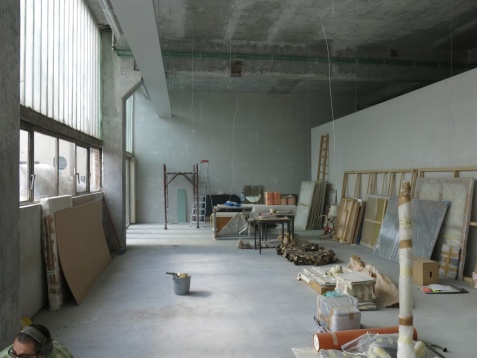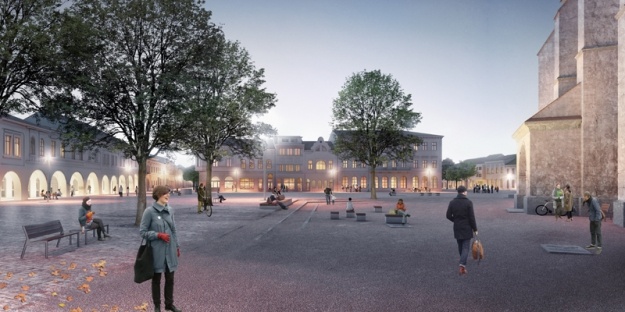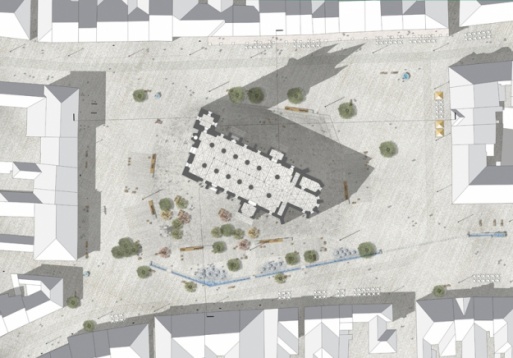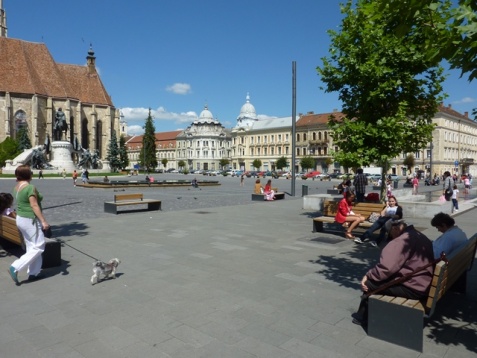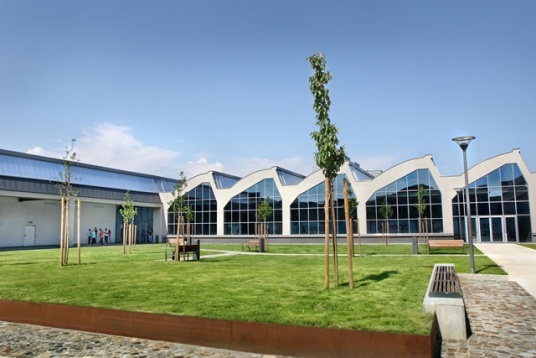HISTORY
Planwerk is working in the fields of architecture, urban planning and the design of public spaces since 2002, for private clients as well as for public authorities. The office is based on the collaboration of Romanian and German architects and planners, combining knowledge of local particularities with a professional vision and the know-how accumulated in more than a decade of experience working in Romania and Germany.
ROMANIAN DESIGN WEEK APPEARANCES
2015 // Central Square, Bistriţa
Transforming the Central Square into a pedestrian surface is an opportunity to activate historical landmarks and traditions of Bistriţa in a contemporary manner that is strongly connected with the life of the city. Freeing up a generous central space, its defragmentation, its spatial and functional unity and cohesion are the main goals of the project. The old footprint of the fortified church is brought to surface in order to gently mediate between the stir of the events and pedestrian flows on the north side and the calm of the urban garden on the south. 2015 // Plan B Gallery-Conversion of an industrial space, Paintbrush Factory, Cluj
2014 // Unirii Square, Cluj
The two-phased architectural competition for the rehabilitation of Piata Unirii and Bulevardul Eroilor was based on a traffic study, which aims to free the center of transit traffic and identified the important, continuous parts of the road network that could be transformed into pedestrian areas, while promoting public transport. The winning project by Planwerk, in collaboration with Kosemund und Putz, is focusing on regaining the unusable and blocked space, giving it back its lost qualities.
The square displays a homogenous surface that stretches along the buildings from east to west. The buildings are located directly adjacent to the square as they were in the past, and they now help define the space. An extended system of low steps along the western side of the square softly accentuates the downward slope and also serves as seating – a „tribune“ - facing the square. Ten sycamore trees and a fountain, consisting of a water bazin, an open field with jets and a water table, enclose the squares southern end. All of the surfaces used by pedestrians are covered in local natural stone. While most of the archeological diggings were closed, the most important part, giving an insight to the roman history of the place, was covered with a horizontal glas surface, surrounded by a wooden bench.
2014 // Coresi Portal, Braşov
The conversion of the former factory halls and brick tower represents the implementation of the new land-use-plan. Likewise is the intervention on the former alleys and green zones a built symbol for the now public use and the linking-up with the city.
The intervention creates a public space which is accessible, welcoming, green, generous and safe.
It represents the respectful treatment of the historic and emotionally charged site by showing off the historic buildings and adding value to the overall existing setting.
The backbone of the space is the 30-45m wide and 700m long main pedestrian axis. It links the south gate entrance-portal with the planned residential area in the north. Flat and elevated planting zones structure and shape the space. Pocket Parks for recreation are spacial openings along the axis.
The principal geometry of the main axis was preserved but adapted to the new functions. Alike materials were chosen regarding the post-industrial context, partly on-site-found material was reused. A contemporary objectiveness and language of form was seeked to mark the time of the intervention and to increase the acceptation by the users.
2014 // Erlebnisraum, Sibiu
Four such projects are implemented in this project: the “ Seating next to the fortified walls”, the “Sun terrace “ closed to the monastery of Ursulines, the entire Square of Goldcraftmen and the refurbishment of the fortified walls on a deteriorated section. The restoration of the stairway connecting Small Square and the Square of Goldcraftmen, the renewal of pavement on Silvercraftmen Street and Marketplace Street (within the “Red carpet” project) extend such measures onto links between already refurbished public spaces. Physical refurbishment, sustained by appropriate traffic calming schemes, consist of placing new urban objects - like forged iron handrails, urban furniture, trees or drinking fountains- , particularized according to their position in the newly refurbished public spaces. Furthermore, refurbishment included a new urban lighting system. Pavement surfaces were made of natural stone: basalt and andesite.
![]()
Planwerk is working in the fields of architecture, urban planning and the design of public spaces since 2002, for private clients as well as for public authorities. The office is based on the collaboration of Romanian and German architects and planners, combining knowledge of local particularities with a professional vision and the know-how accumulated in more than a decade of experience working in Romania and Germany.
FIND OUT MORE ABOUT PLANWERK FROM THIS VIDEO
ROMANIAN DESIGN WEEK APPEARANCES
2015 // Central Square, Bistriţa
Transforming the Central Square into a pedestrian surface is an opportunity to activate historical landmarks and traditions of Bistriţa in a contemporary manner that is strongly connected with the life of the city. Freeing up a generous central space, its defragmentation, its spatial and functional unity and cohesion are the main goals of the project. The old footprint of the fortified church is brought to surface in order to gently mediate between the stir of the events and pedestrian flows on the north side and the calm of the urban garden on the south.
Commonly known, but meanwhile lost historical landmarks of the evolution of the square are integrated and discreetly evoked in the design,e.g: the old guild workshops, the school, the vicarage. By reorganising vegetation, the two traditional areas of the square are again visible, without using clear borders: the old market and the former cemetery. The continuous character of the space and the minimal interventions of the design are balanced by the architectural variety of the (now visible) buildings or with the possible activities and the new created atmospheres.
The art gallery Plan B (Cluj and Berlin) is one of the initiators of the project Fabrica de Pensule / The Paintbrush Factory in Cluj, an independent cultural center, converted from the old paintbrush factory and hosting now art galleries and artist studios. In 2013, the gallery decided to move from one of the upper floors of the Paintbrush Factory to a bigger space on the ground floor of the factory building, accessible directly from the courtyard.
Apart from the showroom, the program includes a storeroom for artworks and a flexible space functioning as office, research space, archive and library for the gallery. The main space of the gallery is used for exhibitions in a classical sense, for performances and workshops.
The project joins two rooms by demolishing a partition wall and inserts a new volume over the length of the space, which is determined by a new, freestanding exhibition wall, hiding the store room and sanitary spaces. Above these, the open office and archive space is sometimes included in the exhibition designs. The implementation of the project is an ongoing process, offering different spatial and atmospherical backgrounds to the exhibitions.
The two-phased architectural competition for the rehabilitation of Piata Unirii and Bulevardul Eroilor was based on a traffic study, which aims to free the center of transit traffic and identified the important, continuous parts of the road network that could be transformed into pedestrian areas, while promoting public transport. The winning project by Planwerk, in collaboration with Kosemund und Putz, is focusing on regaining the unusable and blocked space, giving it back its lost qualities.
The square displays a homogenous surface that stretches along the buildings from east to west. The buildings are located directly adjacent to the square as they were in the past, and they now help define the space. An extended system of low steps along the western side of the square softly accentuates the downward slope and also serves as seating – a „tribune“ - facing the square. Ten sycamore trees and a fountain, consisting of a water bazin, an open field with jets and a water table, enclose the squares southern end. All of the surfaces used by pedestrians are covered in local natural stone. While most of the archeological diggings were closed, the most important part, giving an insight to the roman history of the place, was covered with a horizontal glas surface, surrounded by a wooden bench.
2014 // Coresi Portal, Braşov
The conversion of the former factory halls and brick tower represents the implementation of the new land-use-plan. Likewise is the intervention on the former alleys and green zones a built symbol for the now public use and the linking-up with the city.
The intervention creates a public space which is accessible, welcoming, green, generous and safe.
It represents the respectful treatment of the historic and emotionally charged site by showing off the historic buildings and adding value to the overall existing setting.
The backbone of the space is the 30-45m wide and 700m long main pedestrian axis. It links the south gate entrance-portal with the planned residential area in the north. Flat and elevated planting zones structure and shape the space. Pocket Parks for recreation are spacial openings along the axis.
The principal geometry of the main axis was preserved but adapted to the new functions. Alike materials were chosen regarding the post-industrial context, partly on-site-found material was reused. A contemporary objectiveness and language of form was seeked to mark the time of the intervention and to increase the acceptation by the users.
2014 // Erlebnisraum, Sibiu
Four such projects are implemented in this project: the “ Seating next to the fortified walls”, the “Sun terrace “ closed to the monastery of Ursulines, the entire Square of Goldcraftmen and the refurbishment of the fortified walls on a deteriorated section. The restoration of the stairway connecting Small Square and the Square of Goldcraftmen, the renewal of pavement on Silvercraftmen Street and Marketplace Street (within the “Red carpet” project) extend such measures onto links between already refurbished public spaces. Physical refurbishment, sustained by appropriate traffic calming schemes, consist of placing new urban objects - like forged iron handrails, urban furniture, trees or drinking fountains- , particularized according to their position in the newly refurbished public spaces. Furthermore, refurbishment included a new urban lighting system. Pavement surfaces were made of natural stone: basalt and andesite.
















